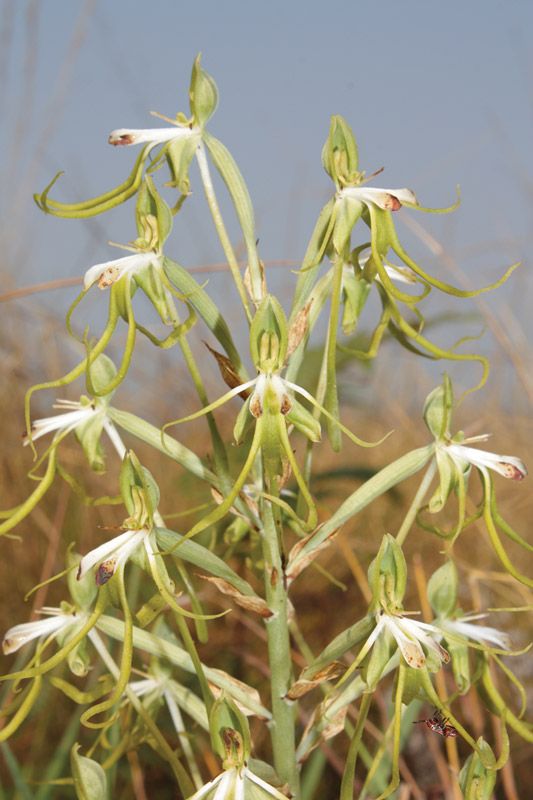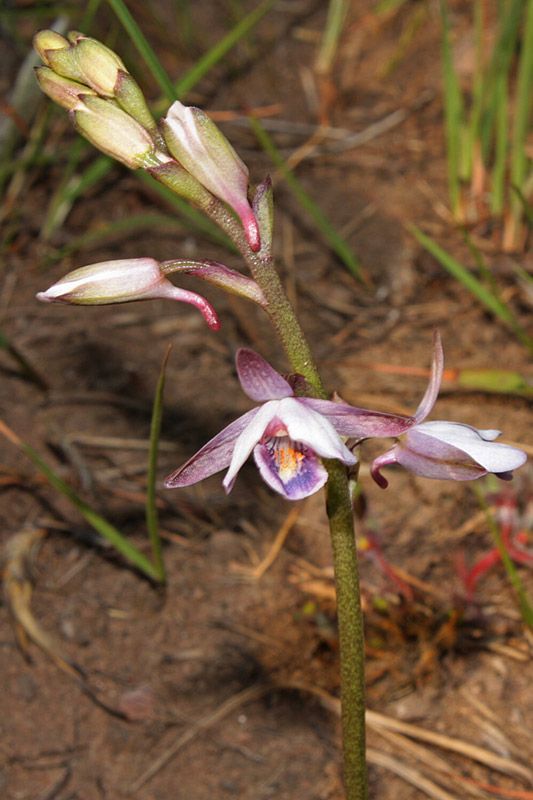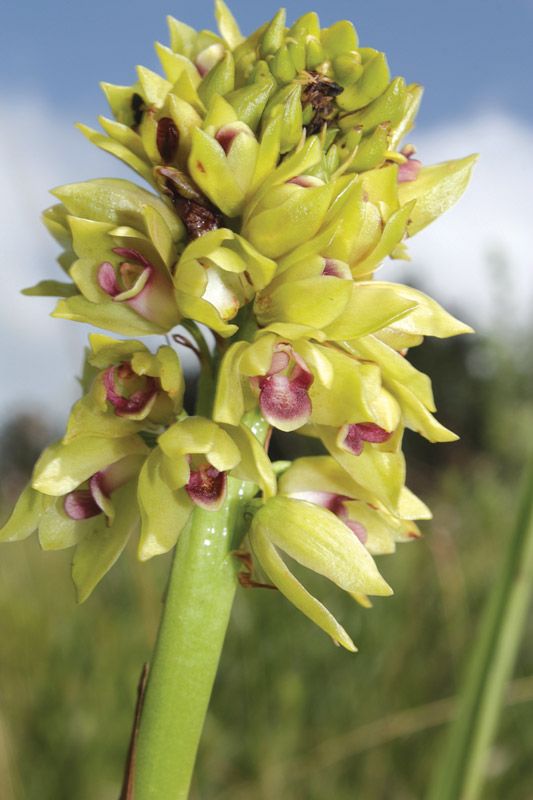The Orchids of Kloof and the adjacent Highway area – Part 1
Text Hendrelien Peters Photographs Hendrelien Peters, Pat Brown
“Many collectors died in process of searching for new species, and despite persistent reports that the men died from drowning, gunshot and knife wounds, snakebite, trampling by cattle, or blows in the head with blunt instruments, it is generally accepted that in each case the primary cause of death was orchid fever.”
Eric Hansen, Orchid Fever: A Horticultural Tale of Love, Lust, and Lunacy
Whilst the passion for orchids can drive many people to do crazy things we are fortunate enough in the Kloof area to enjoy a wealth of orchid species on our doorstep without the threat of death! In a three part series, well-known orchid expert Hendrelien Peters takes us on a journey exploring the species of our area. In Part 1 she introduces us to the genus and then explores the terrestrial species flowering between June and November.
The Orchid family has an estimated 26,000-30,000 species and is reported to be the largest family of flowering plants. Orchids show the greatest diversity in flower structure and are the most highly evolved of all the flowering plants. The highest concentration of orchids is found in tropical America and Asia. These are mainly epiphytic (growing on trees or shrubs) due to the higher rainfall in these warmer climates. The rest of the orchids are terrestrial plants (growing in the ground) which are found in the temperate areas which are either covered with snow or suffer from no rain during the winter season. Their underground tubers sustain them during the months of adversity.
In Southern Africa we are fortunate to have about 480 species of orchids (of these 313 species are endemic to South Africa). The majority are terrestrial while the rest fall into the category of epiphytic or lithophytic (species on rocks). KwaZulu-Natal has approximately 219 species in 43 genera.
The Outer West or Highway area encompasses Kloof, Gillitts, Hillcrest, Botha’s Hill and Assagay. This area (500-700m above sea level) is predominantly grassland with patches of riverine forest and consequently the majority of the species are ground/terrestrial orchids. The Highway area has 61 known orchid species in 22 genera.
The climate is typical subtropical – hot and humid in summer with the average day temperatures of 29⁰C, the winter days about 18-22⁰C with nights seldom going below 10⁰C. Rainfall occurs during the summer months, with little or no rain from May to August. It is, however, the height above sea level and the dry, cool winters that dictate the higher percentage of terrestrial orchids whose underground tubers allow them to be better equipped to cope with this period of lower temperatures, drought and also the occasional fires that spread through the grassland area.
Many of the orchids can be seen with just a short walk into a grassland, however quite a few orchids are elusive and may require a few hours of walking, climbing up hills or over rocky areas, slithering down embankments, or into gorges, through streams always mindful of the wildlife that one can unexpectedly come upon like snakes and ticks when climbing over logs or bashing your way through thick undergrowth. All this however is soon forgotten when that elusive or rare orchid is spotted and photographed.
Orchids are protected species by law and may not to be dugout or the flowers picked for the vase.
One can be greatly tempted to dig out, remove and grow in a garden environment these terrestrial and epiphytic orchids. One must, however, remember that all orchids are protected species – the plants are not allowed to be dug out, the flowers are not allowed to be cut and the seeds are not allowed to be removed.
The second factor to be considered is that the terrestrial orchids are very specific to the little niche that they occupy – namely, the soil type, temperature of the area and their own micro climate. They, therefore, seldom survive when dug out and transferred to a cultivated garden. Our main aim is to conserve the grasslands and the riverine forests and to keep them as pristine as possible, so that we can maintain our superb wild orchid heritage for the next generation to see and enjoy.
How to recognise an orchid in the field
Orchids are closely related to the lily family (monocotyledons).
- They are perennial herbs with no woody parts.
- The leaves are ‘simple’ and are not divided into lobes or smaller leaflets, and are parallel veined.
- The leaves have no stalk and are arranged alternately along the stem.
- The flowers are carried in a single spike at the tip of the stem.
- The ovary is inferior, that is, placed below the sepals and petals.
- Male (stamens) and female (stigma) parts of the flower are not separate but fused together into a single structure, called the column that lies in the centre of the flower.
- The flower is made up of three sepals and three petals but one petal differs from the others, usually more brightly coloured and patterned and, intricately shaped, forming the lip.

Image via HowStuffWorks
Terrestrial orchids in the Highway area
There are a number of relatively common terrestrial orchid species that inhabit our grasslands and riverine forested areas. The season starts in June with the flowering of Eulophia parviflora. There are two forms of this species that occur in our area. First to appear in June to (July and August) is the long-spurred form. This species is a slender terrestrial reaching up to 250mm, laxly few-flowered. The colour of the flowers varies from an olive-green with a light reddish-brown flushing to deep reddish-brown colour. Over the years I have seen two plants with greenish flowers, the albino forms being very rare. This grassland species is common throughout our area and is found from sea level to 1800m.

Eulophia parviflora the long-spurred form with dark coloured flowers.

Eulophia parviflora the long-spurred form with greenish flowers.
The short-spurred form flowers from September to December also occurring in the grasslands often forming dense clumps. The species is a robust terrestrial 200-500mm tall. The flowers which are tightly turned into the stem are a brownish-green outside, mottled with rich russet-brown inside, petals yellow on the outside, veins marked red-brown inside, lip yellow.

Eulophia parviflora the short-spurred form with the flowers tightly bunched around the stem.
There is a third form Eulophia aff. parviflora, which I found in the Krantzview Nature Reserve in the early 1990’s also in Assagay and down the South Coast, the flowers are different from the two above. The flowering stem reaches 30-40cm tall, carrying about 7 flowers which are facing forwards, have broader flower segments and larger than the long-spurred type. It flowers in August when all the long-spurred varieties have died down and it occurs sporadically usually as a single plant. However this particular form of the species has yet to be acknowledged by the botanists.

Eulophia aff. parviflora.
In July Eulophia clitellifera starts flowering, usually in relatively rocky areas. The plant reaches about 350mm but because it has very small 1cm flowers, it can be very difficult to spot in burnt veld. The flowers are quite stunning and are often covered with reddish burgundy veins.

Eulophia clitellifera the plant in situ.

Eulophia clitellifera close-up of flowers.
Bonatea porrecta, a fairly robust terrestrial up to 560mm tall, is the next to appear. Leaves withered at time of flowering. Inflorescence lax, 3-36 flowered. Flowers white and green, about 40mm long. This species is found occasionally in grassland, from 150-1,800m. Flowers appear between June and August.

Bonatea porrecta.
Eulophia hians var. hians (syn. E. clavicornis var. hians). Next to appear (August to December) is this slender terrestrial 110-920mm tall. Although they are tall they are extremely difficult to spot because they are so slender and the flowers are not very big. The inflorescence bears 3-40 flowers, and vary in colour from white, through shades of pinkish-purple to purple. It occurs in a wide variety of habitats from wet coastal to dry grasslands, from the coast to 2500m.

Eulophia hians var. hians.
Disa woodii This delightful orchid appears in October (September to November), with its yellow flowers looking like a candle appearing above the grass. The species is very common in Kloof, in grasslands, roadside embankments and damp conditions, from near sea level to 1400m, usually found on south facing banks. It is often seen along the M13 from Cato Ridge to E. B. Cloete Interchange on the N2. The inflorescence reaches between 150-700mm in height, in the Kloof area seldom exceeds 300mm, is dense, cylindrical carrying 40-150 flowers. The flowers are bright yellow about 1cm in diameter. On the south-facing grassy slopes above the N2 in the Key Ridge area, they are found in their hundreds.

Disa woodii a most magnificent colony with at least 20 plants per square metre.

The inflorescence of Disa woodii. Photographer: Pat Brown

Disa woodii: close-up of the flowers. Photographer: Pat Brown
It is a pioneer species, and self-pollinating. Disa woodii will populate a disturbed area for a few years and then just disappear as the surrounding grassland spreads and the shrubs grow bigger.
Flowering between August and January is Orthochilus leontoglossus (syn. Eulophia leontoglossa). Yet another grassland species, but seldom reaching 300mm in height and is often dwarfed by the other vegetation around it. The plants are quite stout and carry a head of about 35 flowers which are bright yellow; the lip is covered in short, dark brown hairs-hence the specific epithet leontoglossus meaning “lion-like tongue”. This species is found from near sea level to 2,200m frequently in dry, moderately moist and occasionally marshy areas in grassland.

Martin Rautenbach photographing the small Orthochilus leontoglossus in situ.

Orthochilus leontoglossus.
Flowering at the same time as the previous species, is Orthochilus foliosus. This is the most common species in our area, and can be found growing in colonies of a few hundred plants often on south to south-east facing grassy hillsides. It is a fairly stout species 150-450mm tall. The inflorescence dense, bearing up to 40, dull lime-green to yellowish-green flowers, the lip flushed with dark purple. The flowers are inclined to be bell-shaped and facing downwards. It is found from near sea level to 2,000m.

Orthochilus foliosus in situ.

Orthochilus foliosus in situ.

The grassland with literally hundreds of plants of Orthochilus foliosus in bloom at the same time. Photographer: Alan Townsend
Also flowering in November, is the beautiful Eulophia cucullata which was once abundant, but now rare, due to urbanization and the increased use of land for agriculture. This species is only found in remote areas. After having being missing for the past 30 years, it was recently rediscovered in the area.
A slender plant having a 300-500mm flower stem carrying 3-15 large, 30mm diameter, sweetly scented flowers which range from bright pink to white tinged pale purplish-pink.

The rediscovered Eulophia cucullata.

Eulophia cucullata with its stunning pink flowers.
The plants are found in a narrow belt along the KwaZulu-Natal coast, and a small colony in Mpumalanga but widespread in the rest of tropical Africa. It is usually found in grassy places in coastal bush or on the verge of marshes. This species is used in traditional medicine to treat impotence and barrenness and as a love charm.
Flowering at the same time is Orthochilus ensatus. This species has tall flowering stems up to 100cm, each inflorescence carries up to 30, bright to pale yellow flowers in a dense mass. The flowers are about 24mm long. Rare to locally frequent often forming colonies in open grasslands or grassy places in coastal bush in full sun to moderate shade.

A colony of Orthochilus ensatus.

Orthochilus ensatus: the dense inflorescence carrying up to 30 flowers. Photographer: Pat Brown
The plants are distributed in a narrow belt along the coast up to 40km inland, from the Eastern Cape through KwaZulu-Natal into Swaziland, Mpumalanga and Limpopo Province. Orthochilus ensatus is also used in traditional medicine.
Satyrium longicauda var. longicauda. This species makes its appearance usually in November. It is a relatively common terrestrial orchid in our grasslands and is a fairly robust species that can grow to 800mm. The flowers on the inflorescence can vary from white to white with pink flushing to pink in the Drakensberg area. Its range is from sea level to 3000m.

Satyrium longicauda: the white form.

A close-up of the white and pink form of Satyrium longicauda. Photographer: Pat Brown
Flowering in early November is the stunning and robust Satyrium sphaerocarpum. The burgundy coloured flower stems reach up to 500mm, with a densely flowered inflorescence. The flowers are large 27-30mm in diameter, faintly scented, white to cream, speckled and streaked with dark reddish-brown to purple in our area.

Satyrium sphaerocarpum
This species is usually found growing in moist grassland, often on roadside embankments from the Eastern Cape through KwaZulu-Natal into Mozambique.
Brachycorythis ovata. This grassland species occurs between 240m to 1800mm and flowers between September and January. A fairly robust species that can reach a height of 250-600mm carrying a densely flowered inflorescence of 20-100 flowers, which are rather fleshy, white with suffused shades of mauve-pink to purple.

Brachycorythis ovata: the densely flowered inflorescence. Photographer: Pat Brown

Brachycorythis ovata: close-up of the flowers. Photographer: Pat Brown
Brachycorythis pubescens is a tall species reaching 600mm. All the parts of the plant are covered with fine hairs. The tall densely flowered inflorescence carries about 45 to 110 flowers, which are a light to deep pink. This grassland species flowers between October and December and widespread from the coast to about 1500m above sea level.

Brachycorythis pubescens: the whole plant.

Brachycorythis pubescens: close-up of the inflorescence.

Brachycorythis pubescens: close-up of the flower. Photographer: Pat Brown
Corycium dracomontanum is a slender terrestrial reaching from 220mm to 500mm tall. The inflorescence dense, 20-50 flowered. The tiny ball-like flowers are pale green turning burgundy-black with age. It is common in grassland from near sea level to 3000m. Very closely related to Corycium nigrescens but differs in the lip structure – in C. nigrescens the lateral appendages of the lip are oblong and facing sideways. This species flowers in our area from October to December.

Richard Lundie and Janet Gates photographing Corycium dracomontanum at the Bridle Road view site during a CREW outing.

The inflorescence of Corycium dracomontanum showing it most unusual ball-like flowers.

Corycium dracomontanum: close-up of the flowers.
Disa brevicornis is a slender grassland terrestrial 200-500mm tall. Inflorescence lax, 20- 45 flowered. The predominant colour of the down-facing flower is a pinkish-maroon on the outer surface with the inner flower parts a lime green. Flower about 15-20mm long. This species is widespread and locally abundant in montane grassland, although it has been recorded from near sea level to 2,700m. It flowers between August and February, stimulated by fire.

The very slender Disa brevicornis.

A close-up of the 20mm long flowers of Disa brevicornis.
In Part 2 will cover those species flowering from December to May as well as some of the Epiphytic species. Part 3 will cover the rarer species.
Acknowledgements
I would like to thank Tessa Rakow (Secretary of the South African Orchid Council) from Johannesburg, for editing this article.

About the author
Hendrelien Peters originally qualified as a History, Geography and Physical Education teacher and has been growing orchids since 1982. She qualified as a South African Orchid Council judge in 1985. Hendrelien currently curates the orchid collection at the Durban Botanic Gardens and is the editor of Orchids South Africa. Her hobbies include photography, art and searching for indigenous orchids.